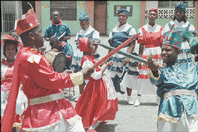Claude Mills, Staff Reporter

Members of the Manchioneal Cultural Group demonstrate "Bruckins", a traditional Jamaican dance, during an impromptu performance at the Manchioneal All-Age School, east Portland.
MANCHIONEAL. The word rolls off your tongue like memories of a magical place.
But there's nothing romantic about the origin of the name of this seaside town in eastern Portland. It has its roots in a poisonous tree that once lined the coast.
The word "Manchioneal" comes from the Spanish Manzanella (little apple), the fruit of the Manchineel tree. The leaves of the tree, when crushed, the juice from the (hippomane) apple, and the sap from the tree are poisonous.
Legend has it that the English, hiding in Manchineel trees, would poison invading Spaniards who would stop to rest under the shade of the trees. The English, it is said, cut the tree, dumping the sap on the invaders, according to Richard Derby, head of the Manchioneal Cultural Group.
"The sap would blister their skin and lead to their eventual death, the legend goes," Mr. Derby said.
Locals also claim that the Arawaks, Jamaica's first inhabitants, dipped the tip of their arrows in the juice and people have been reported to go blind after being hit in the face by crushed Manchineel leaves, blown by hurricane-force winds.
There are only two trees left in the town, one is located at the famous "fry-fish" spot, the Mother May corner, and the other on the Villa property which is now used primarily to rear cattle.
There was a time when Manchioneal, Portland's third largest town, was famous for its coconuts. In recent times, however, the population of coconut trees, particularly those near the coast, has been wiped out by the Lethal Yellow disease. Next door to the Manchioneal All-Age School, a stand of decapitated, leafless trees is a stark reminder of the impact of the disease.
Bruckins
These days the town which was owned by William Bryan in 1811 is renowned for its mastery of the dance, "Bruckins". For the last three years the Manchioneal Cultural Group has had a stranglehold on the Imogene "Queenie" Kennedy Award as "Best Traditional Adult Group" in the annual JCDC Jamaica Festival Compe-tition.
At heart, this community of about 5,000 is essentially a fishing village though fishermen say they're down on their luck because hotels are now opting for imports.
Still, town folk believe in being self-reliant and are looking at cottage industries to support themselves, said Denroy Palmer, president of the Manchioneal Community Club.
The biggest land owner in the community, Dr. Richard Jones, managing director of the Fred M. Jones Estate, believes that "for this community to be self-sufficient, it has to get involved in farming."
Putting action behind his words, Dr. Jones has allocated 50 acres of land to small farmers in the area and they are producing bananas and other crops.
During its early development, armed conflicts between the English and the Maroons and rough terrain of the land, Jamaicans had to be bribed with goods such as flour to settle in Portland.
At the time Manchioneal was the only residential area in that section of the parish and boasted great estates of pimento and other crops. It was the hub of Portland's social life. It was home to high-powered residents like Governors Eyre and Darling.
Famous residents
Today's famous residents include Keith Bryan, carpenter, lay preacher and community leader, and 1994 recipient of the Governor-General's Award. He is called "The living history book"). Others of note include Richard Derby, who won the National Youth Leaders Contest in 1996.
Landmarks include the Manchioneal Methodist Church, located on a hill on the way to a fort where slaves used to gather for meetings.
"There is a mango tree where you can see the markings where a bell was hung to signal to the slaves to meet," said Icilda Salmon, a resident.
Other landmarks include the remains of an old army regiment and barracks, strategically located in east Portland to keep out the Spaniards. In the bay, there are black pillars of an old port that in the 1800s did a roaring trade in bananas and figs.
Also, there is Kendall Castle, a brick building which reportedly was the first meeting place of the Methodists.















































